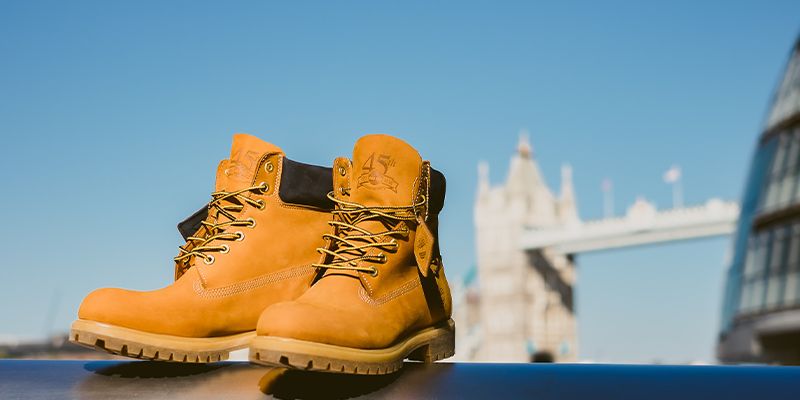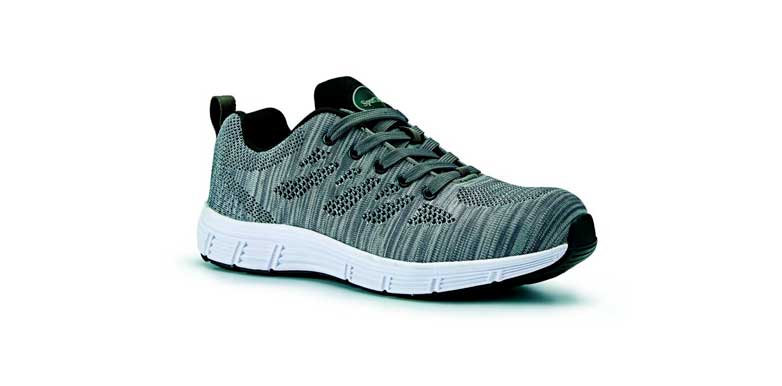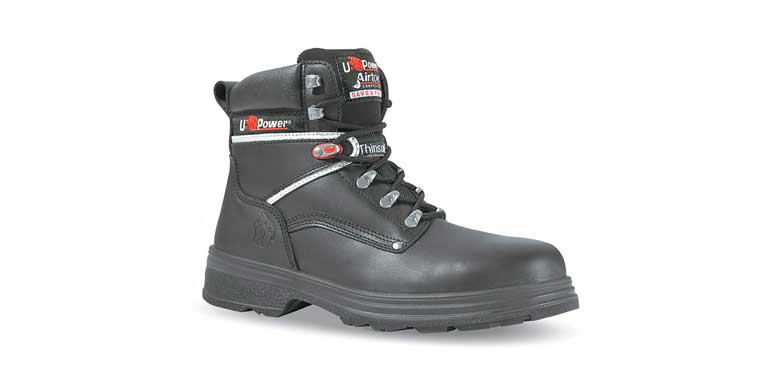Guide to Safety Footwear

There are many different types of safety footwear available. You may have seen all of the different codes they come with, which symbolise the safety features they’re equipped with. If you’ve never shopped for safety footwear, however, it can all be a bit confusing. That’s why we’ve broken it all down for you in this article. We’re going to talk you through what each code means, as well as more information on how to care for your new safety shoes.
Firstly, there are legal requirements for workplaces around Personal Protective Equipment (PPE), which is a catch-all term for things like safety workwear and safety footwear. Every workplace should have regular risk assessments to assess what PPE is required for their staff to do their jobs safely. It’s illegal for staff not to wear required PPE, so it’s important to make sure the equipment is kept clean and well-maintained.
To ensure that manufacturers produce PPE up to an effective standard, there is a European regulation in place referred to as EN ISO 20345. There are two other standards which fall under this, namely EN ISO 20346 and EN ISO 20345:2011. These two standards refer to the level of protection provided and are both different. EN ISO 20345:2011 has been tested for standard protection in the workplace whereas EN ISO 20346 has been put in place for workplaces that only require a low level of protection.
To help you choose the right pair of safety boots, shoes or trainers, a number of safety codes have been created. These codes each indicate a different class of protection, or a different protective quality the boot may possess.
Safety Footwear Safety Codes
Here’s a list of the common abbreviations you’ll see when shopping for your next pair of work boots:
P This code is used to signify that the shoe or boot has mid-sole protection to prevent sharp objects such as nails from being penetrating the sole. The footwear must be able to resist a penetration force of at least 1100N to comply to this standard. This is usually achieved with a stainless steel or aluminium insert in the sole or an insole made from Kevlar which is an incredibly strong synthetic fibre and is in fact five times stronger than steel.
HRO This code stands for a Heat Resistant Outsole. This means that the material that the soles are made from must be able to withstand heat up to 300 degrees Celsius.
A This stands for Antistatic protection, which means the boot reduces the possibility of static being created. This diminishes the risk of sparks which can be dangerous if you’re working around flammable substances or vapours. It also reduces the risk of electric shocks and provides an electrical resistance of between 0.1 to 1000 MegaOhms between your foot and the ground.
C This code symbolises Conductive footwear. This means that your safety footwear helps to prevent a build-up of static electricity on the body. The footwear is made with materials and cements that have no electrical resistance.
I This code stands for Electricity insulating footwear and should be made from a material that an electrical charge cannot flow through.
HI This code ensures that the footwear provides heat insulation. The footwear is tested to temperatures of 150 degrees Celsius and must see a temperature increase of less than 22 degrees Celsius to the upper surface of the insole after 30 minutes.
CI Stands for Cold Insulation, which is provided by the outer sole. The sole is tested against temperatures of -17 degrees Celsius and it also has to show that the insole is no higher than 10 degrees Celsius
M This code stands for Metatarsal Protection. This means that in addition to a steel or composite toe cap, the safety boot is equipped with additional protection for the midfoot. This protects you against more serious compression injuries. This is particularly relevant in workplaces where there is a risk of heavy items falling or rolling onto the top of the foot.
AN AN stands for Ankle Protection. Safety footwear with this code should have undertaken an impact test to show that it provides ankle protection for the wearer.
CR This stands for Cut Resistant Upper and specifies that the footwear is designed to protect the foot from cuts.
E This code refers to increased energy absorption of 20J in the heel. This helps to make the footwear more comfortable. Safety boots with an ‘E’ standard classification are perfect as roofing boots, or for anyone else working long shifts on their feet all day.
FO This means that the safety shoes or boots are resistant to both fuel and oil. This usually refers to the top of the shoes and does not mean that the soles are slip resistant (see below for more information regarding slip resistance standards).
WR Refers to Water Resistance and means that the safety footwear can resist the ingress of water to some degree (only shoes labelled waterproof will completely stop water entry).
WRU This is similar to WR but means that it’s just the upper of the footwear that is water resistant.

Safety Footwear Classifications
In addition to the abbreviations for individual features, EN ISO 20345:2011 also sets out a number of standard classifications based on minimum requirements. When you go to purchase safety footwear you’ll always see one of these such as SB or S3, followed by a series of abbreviations from the above list to indicate additional features.
SB SB stands for Safety Basic, which as the name indicates is the base level of protection provided by safety footwear. Most pairs of safety shoes or trainers you find will comply to Safety Basic at least, as well as one or more of the additional qualities above.
SB requires that the shoes be equipped with toe protection which can withstand an impact of 200 joules. 200J is the equivalent of a 22.7kg (or 50lbs) weight falling onto your foot from a height of 56cm. SB standards also require that the footwear be able to withstand a weight of 1.5 tonnes resting on the toe area.
Both standards above are usually achieved by equipping the shoe with a steel toe cap, although in recent years more modern alternatives are taking steel’s place. One prominent example is composite toe caps, which are far lighter than steel and made from a combination of materials such as Kevlar, Carbon Fibre, Plastic or Fibreglass.
As stated, SB forms the basic level of protection for safety footwear, and any additional classifications are combinations of SB along with additional protection identified by abbreviations above.
SBP indicates a safety shoe rated SB that is also equipped with mid-sole protection (P).
S1 includes the requirements of SB, A and E.
S1P Includes the requirements of SB, A, E and P.
S2 Includes the requirements of SB, A, E and WRU.
S3 Includes the requirements of SB, A, E, P and WRU.
As one of the most stringent levels of foot protection, if you’re working on a roofing project, then we’d recommend S3 safety boots. Not only will your feet be protected from accidental impacts, but the additional ankle support and slip resistance will also be greatly beneficial.
Non-Slip Safety Footwear
There are also separate standards for slip resistance to ensure that your new safety footwear is non-slip:
SRA: Footwear marked with SRA has been tested on ceramic tiles covered with a diluted soap solution and shown to be slip resistant.
SRB: This symbolises that the footwear has been tested on a smooth steel surface covered with glycerol and has still been slip resistant
SRC: This means that the footwear has proven to be slip resistant against both SRA and SRB conditions.

When Should You Wear Safety Shoes?
Safety footwear is required when the wearer is working in an environment where there is a risk of injury. This includes when working with hazardous materials, electrical instruments, sharp or heavy objects or when operating heavy machinery. All workplaces should perform regular risk assessments to identify any requirements for Personal Protective Equipment, and let staff know the outcome of these.
Should You Inspect Safety Shoes?
Safety shoes and boots should be inspected before and after every use. Ideally, this should be carried out by a trained member of staff in the workplace. They should check for any holes, cracks or tears; or anything else which compromises the safety of the wearer and compliance with legal standards.
Do Safety Shoes Expire?
You can expect a pair of safety shoes to last between 6 and 12 months of regular use, although some pairs may last longer. This is why we recommend you purchase at least one alternative pair so your safety footwear can last for longer and be allowed to dry completely between wears. If the footwear becomes damaged in any way, however, or begin to show signs of wear, then they should be replaced immediately as they may no longer meet safety regulations.
Further Information
We now stock safety footwear from Rugged Terrain, including safety shoes, safety boots, safety trainers and a range of safety shoes for women here at Roofing Megastore. If you need any further information about any of the products you can ask our friendly customer services team who can be reached on 01295 565565, via the live chat on the website or at [email protected].
You can also follow us on Facebook, Instagram or Twitter for further hints and tips and brilliant discounts and offers.
Please note: This guide on ' Safety Footwear’ has been written for information purposes only and we therefore take no responsibility for any purchasing decisions you make as a result of reading this article. Whilst we act as a retailer, we are not experts and we therefore recommend that you also refer to your manufacturer's guide and, if appropriate, consult a qualified professional before you make any final decisions.